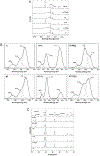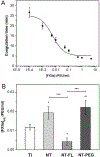Interaction of blood plasma proteins with superhemophobic titania nanotube surfaces
- PMID: 31279063
- PMCID: PMC6814547
- DOI: 10.1016/j.nano.2019.102046
Interaction of blood plasma proteins with superhemophobic titania nanotube surfaces
Abstract
The need to improve blood biocompatibility of medical devices is urgent. As soon as blood encounters a biomaterial implant, proteins adsorb on its surfaces, often leading to several complications such as thrombosis and failure of the device. Therefore, controlling protein adsorption plays a major role in developing hemocompatible materials. In this study, the interaction of key blood plasma proteins with superhemophobic titania nanotube substrates and the blood clotting responses was investigated. The substrate stability was evaluated and fibrinogen adsorption and thrombin formation from plasma were assessed using ELISA. Whole blood clotting kinetics was also investigated, and Factor XII activation on the substrates was characterized by an in vitro plasma coagulation time assay. The results show that superhemophobic titania nanotubes are stable and considerably decrease surface protein adsorption/Factor XII activation as well as delay the whole blood clotting, and thus can be a promising approach for designing blood contacting medical devices.
Keywords: Factor XII; Fibrinogen; Hemocompatibility; Protein adsorption; Superhemophobic; Titania nanotubes.
Copyright © 2019 Elsevier Inc. All rights reserved.
Figures








Similar articles
-
Enhanced hemocompatibility and antibacterial activity on titania nanotubes with tanfloc/heparin polyelectrolyte multilayers.J Biomed Mater Res A. 2020 Apr;108(4):992-1005. doi: 10.1002/jbm.a.36876. Epub 2020 Jan 11. J Biomed Mater Res A. 2020. PMID: 31909867 Free PMC article.
-
Hemocompatibility of titania nanotube arrays.J Biomed Mater Res A. 2010 Nov;95(2):350-60. doi: 10.1002/jbm.a.32853. J Biomed Mater Res A. 2010. PMID: 20629021
-
Hemocompatibility of Superhemophobic Titania Surfaces.Adv Healthc Mater. 2017 Feb;6(4). doi: 10.1002/adhm.201600717. Epub 2016 Dec 21. Adv Healthc Mater. 2017. PMID: 28000420
-
The blood compatibility challenge. Part 2: Protein adsorption phenomena governing blood reactivity.Acta Biomater. 2019 Aug;94:11-24. doi: 10.1016/j.actbio.2019.06.022. Epub 2019 Jun 18. Acta Biomater. 2019. PMID: 31226477 Free PMC article. Review.
-
Thrombus formation on polymeric materials. IV. Behavior of blood proteins at interfaces.Minn Med. 1971 Aug;54(8):635-41. Minn Med. 1971. PMID: 4934851 Review. No abstract available.
Cited by
-
Recent Developments in Blood-Compatible Superhydrophobic Surfaces.Polymers (Basel). 2022 Mar 8;14(6):1075. doi: 10.3390/polym14061075. Polymers (Basel). 2022. PMID: 35335407 Free PMC article. Review.
-
Tanfloc-Modified Titanium Surfaces: Optimizing Blood Coagulant Activity and Stem Cell Compatibility.ACS Biomater Sci Eng. 2025 Mar 10;11(3):1445-1455. doi: 10.1021/acsbiomaterials.4c02106. Epub 2025 Feb 27. ACS Biomater Sci Eng. 2025. PMID: 40013664 Free PMC article.
-
Blood Coagulation on Titanium Dioxide Films with Various Crystal Structures on Titanium Implant Surfaces.Cells. 2022 Aug 23;11(17):2623. doi: 10.3390/cells11172623. Cells. 2022. PMID: 36078030 Free PMC article.
-
Titania nanotubes modified with copper enhance osteogenic differentiation of adipose derived stem cells.RSC Adv. 2024 Oct 29;14(46):34362-34371. doi: 10.1039/d4ra05038j. eCollection 2024 Oct 23. RSC Adv. 2024. PMID: 39473793 Free PMC article.
-
Tanfloc/heparin polyelectrolyte multilayers improve osteogenic differentiation of adipose-derived stem cells on titania nanotube surfaces.Carbohydr Polym. 2021 Jan 1;251:117079. doi: 10.1016/j.carbpol.2020.117079. Epub 2020 Sep 12. Carbohydr Polym. 2021. PMID: 33142622 Free PMC article.
References
Publication types
MeSH terms
Substances
Grants and funding
LinkOut - more resources
Full Text Sources
Other Literature Sources
Research Materials

